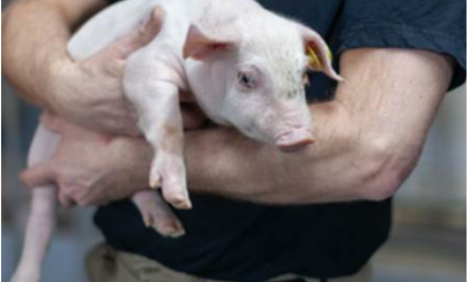



Water Quality and Weanling Pig Performance
By John Patience, Nadine Possberg and Doug Gillis, Prairie Swine Centre - Few well-controlled studies have investigated the impact of poor quality water on pig performance; most suggest the pig is capable of handling relatively high concentrations of sulphates and other mineral contaminants without apparent effect. However, claims from field workers suggest that under farm conditions, water quality is an important issue that has not yet been adequately addressed.SUMMARY

Two experiments were conducted to determine how pigs react to poor quality water under
commercial farm conditions. They were carried out on a Saskatchewan commercial farm,
where the well water was high in sulphates, total dissolved solids and iron; an on-site reverse osmosis unit provided high quality water for comparison.
Although diarrhoea was observed, water quality had no impact on weanling pig performance or
nutrient digestibility. Based on these results, along with previous research, it can be concluded that pigs weaned at three weeks of age have the ability to handle relatively high quantities of sulphate in their drinking water and maintain overall growth performance. It can further be concluded that the presence of diarrhoea alone, associated with high sulphate water, cannot necessarily be linked to poor animal performance.
INTRODUCTION
Water quality remains a controversial topic. Controlled studies suggest that the pig can perform very well when the drinking water contains 1,000 ppm or more of sulphates. Yet, claims from field workers suggest that under farm conditions, water quality is a serious problem. The suggestion is that conditions on farms are sufficiently different that institutional research results are not reflective of what is happening commercially.
We were very fortunate to be presented with the opportunity to conduct a large scale study on a commercial farm, where the well water was very high in sulphates, total dissolved solids and iron. An on-site reverse osmosis unit allowed us to compare the untreated well water with the same water with the minerals removed. The objective of the experiment was to determine if
water high in mineral contaminants would affect the health, performance and nutrient utilization of pigs weaned at about three weeks of age.
MATERIALS AND METHODS
Two experiments were conducted on a 1,200 sow farrow-to-finish commercial farm. There was
excellent co-operation on the part of both the owner and the staff of the farm.
Water was obtained either directly from a deep well or treated first by reverse osmosis (RO)
prior to delivery to the pig herd (Table 1). Alternate pairs of pens were assigned to water source.
| Table 1. Average water composition used in the experiment | |||
| Analyte | Units | Control Water | Treated Water |
| Total Dissolved Solids | mg/L | 3086 | 193 |
| Sulphate | mg/L | 1634 | 15 |
| Sodium | mg/L | 163 | 45 |
| Magnesium | mg/L | 186 | 8 |
| Total hardness | mg/L | 1795 | 80 |
| Nitrate nitrogen | mg/L | 0.03 | 0.32 |
| Nitrite nitrogen | mg/L | BDL | 0.07 |
| pH | 7.56 | 6.93 | |
| Iron | mg/L | 7.24 | 0.43 |
All assays conducted by the Saskatchewan Research Council
“Control” water was delivered directly to the pigs without treatment;
“Treated” water was passed through a reverse osmosis unit prior to delivery to the pig.
In the first experiment, within each water source, approximately half of each pair of pens was assigned to Balpi dish-type drinkers and half to nipple-type drinkers. In the second experiment, half of the pens within each water treatment were assigned to a control starter diet, while the other half received the same starter diet with zinc oxide removed.
Both experiments consisted of all male pigs from one week’s weaning. The pigs remained in the
nursery for five weeks following weaning at about 21 days of age. All pigs were weighed
individually on the day of weaning and on Days 18 and 35 thereafter. Feed intake and feed
conversion were also recorded. Nutrient digestibility was determined by using a special batch of starter diet into which chromic oxide was added at the rate of 0.4%. Faeces were collected on Days 6 through 9 inclusive following introduction of the marker into the diet.
RESULTS AND DISCUSSION
Animal performance (Table 2) was unaffected by water source in experiment 1 (P > 0.10).
However, there was a tendency for the dish-type drinker to improve feed conversion (P < 0.10) in the last half of the nursery period. Although the data are not presented in the tables, there was no effect of water quality on pig performance in the early grower period (P > 0.10).
| Table 2. Impact of water quality and drinker type on pig performance: Exp. 1; | ||||
| Control Water | Treated Water | |||
| Nipple | Dish | Nipple | Dish | |
| Initial wt.; kg | 5.97 | 5.85 | 5.73 | 6.06 |
| Final wt.; kg | 21.25 | 21.39 | 20.18 | 21.77 |
| No. pigs | 62 | 53 | 63 | 54 |
| No. pens | 7 | 6 | 7 | 6 |
| Ave. gain/d, kg | 0.437 | 0.444 | 0.413 | 0.449 |
| Ave. feed/d, kg | 0.675 | 0.665 | 0.637 | 0.668 |
| Gain:feed | 1.54 | 1.49 | 1.54 | 1.49 |
Dish-type drinkers offered a clear benefit over the nipple drinkers in terms of water
disappearance (Table 3). Pigs using the nipple-type drinkers used approximately 67% more
water than those on the dish-type drinkers. Water disappearance differs from water intake, in
that it represents the sum of intake and wastage. The reduction in disappearance with the dishtype drinkers is assumed to reflect reduced wastage, not reduced intake. The fact that dish-type drinkers supported performance at least equal to the nipple-type drinkers tends to validate this conclusion.
| Table 3. Impact of water quality and drinker type on water disappearance (mL/day): Exp. 1 | |||||
| Control Water | Treated Water | ||||
| Nipple | Dish | Nipple | Dish | ||
| - 0 to 3 days | 1331 | 1496 | 2207 | 1448 | |
| - 0 to 7 days | 1401 | 1065 | 1632 | 1273 | |
| - 0 to 21 days1 | 2145 | 1209 | 2073 | 1245 | |
| - 0 to 35 days1 | 2972 | 1666 | 2636 | 1679 | |
Reduced water disappearance represents large savings to the pork producer, not only in water
usage, but also in slurry production.
All of the diets used in the first experiment, contained zinc oxide at 3,000 ppm. In the second experiment, the impact of removing zinc oxide on the response of the pigs to poor quality water was examined. The pigs receiving the raw well water in combination with the zinc oxide in the diet had the lowest final weight overall. However, the difference was not statistically significant.
The pigs receiving the raw well water with no zinc oxide had final weights equal to those of the pigs receiving the treated water (Table 4).
| Table 4. Impact of water quality and zinc oxide supplementation on pig performance: Exp. 2 | ||||
| Control Water | Treated Water | |||
| No Zinc Oxide | Zinc Oxide | No Zinc Oxide | Zinc Oxide | |
| Initial wt.; kg | 5.84 | 5.85 | 5.85 | 5.89 |
| Final wt.; kg | 19.36 | 18.54 | 19.37 | 19.33 |
| No. pens | 6 | 6 | 6 | 6 |
| Ave. gain/d, kg1 | 0.410 | 0.385 | 0.410 | 0.407 |
| Ave. feed/d, kg1 | 0.674 | 0.607 | 0.656 | 0.642 |
| Gain:feed | 0.611 | 0.635 | 0.628 | 0.635 |
2 Diet x water interaction significant, P < 0.05
The addition of zinc at the rate of 3,000 ppm depressed growth rate and feed intake in the first three weeks after weaning when the pigs received the untreated water (P < 0.05); the effect was more pronounced on the poor quality water. Zinc oxide depressed feed intake in the first three weeks after weaning. It also improved feed efficiency, but only when poor quality water was utilized, and then only in the final 12 days of the experiment.
It is quite clear that water quality had no impact on the pigs’ ability to digest dry matter, energy, nitrogen or fibre (Table 5).
| Table 5. Impact of water supply on nutrient digestibility (%) | ||
| Nutrient | Control Water | Treated Water |
| Dry Matter | 82.0 | 82.5 |
| Energy | 82.4 | 82.2 |
| Nitrogen | 80.5 | 80.0 |
| Acid detergent fibre | 24.9 | 25.5 |
| Neutral detergent fibre | 55.9 | 56.2 |
IMPLICATIONS
Two experiments conducted under commercial farm conditions failed to show any adverse
effect of high sulphate levels in the drinking water. These results are heartening to the pig
industry, as it suggests that high sulphate levels in the drinking water need not necessarily lead to insurmountable problems with young pigs.
While high sulphate water results in diarrhoea, one must be careful in concluding that scouring pigs are poor performing pigs. As demonstrated in these two experiments, which involved more than 500 pigs, newly weaned pigs can grow very well in the face of high sulphates in their drinking water and with varying degrees of diarrhoea induced by these high sulphate levels.
The study was not conducted beyond the nursery, as early measurements taken in the grower barn revealed no effect of water source on animal performance.
ACKNOWLEDGEMENTS
The authors thank Stomp Pork Farms and their staff for kindly allowing the use of their facilities and for their excellent co-operation. Financial support from PAWBED, the Canadian Feed Industry Association (Saskatchewan Division), Hillcrest Farms Ltd., Kenpal Farm Products, King Lee Technologies, Central Water Conditioning, Hydranautics Inc., Masterfeeds and Shamrock Feeds was greatly appreciated.
Analytical assistance by the Saskatchewan Research Council is gratefully acknowledged. The authors also acknowledge the pork producers of Saskatchewan, Manitoba and Alberta for their strategic funding to Prairie Swine Centre Inc.
Source - Prairie Swine Centre - July 2003








